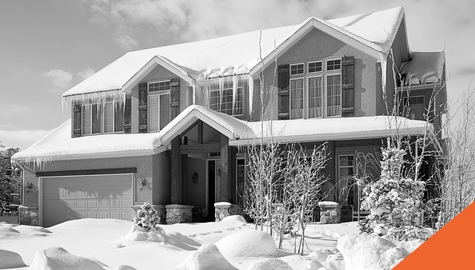How Much is House Insurance? A Detailed Look at Costs and Factors
Thursday, 21 December 2023
Purchasing a house is one of the most significant milestones a person can achieve in their life. It is a place to set roots and build memories you will cherish for years. For most homeowners, this is the largest investment they will ever make. That’s why securing it with an insurance policy that provides the best protection is a must. But how much is house insurance? While there’s no real straightforward answer to that question, this blog will investigate home insurance prices and the details that will play a part in determining how much you pay for your coverage.
Factors Influencing the Cost of Home Insurance
When requesting a quote for home insurance, you will be asked different questions about yourself, anyone living with you, and your home. This helps insurance providers build a risk profile for your situation so that they can find sufficient policies for you. More details on what information is required are below.
Location and Its Impact on Home Insurance Rates
The area in which you live greatly impacts the amount you pay for home insurance. Insurance companies will review stats regarding the crime rate in your neighbourhood to determine if there is a chance of theft or vandalism occurring to your property.
The environment you live in will be considered as well. Properties within regions where forest fires can occur and areas at risk of experiencing a flood are examples of how Mother Nature can influence your premium. Basically, the higher the risk of something bad happening, the more you will likely pay.
The Size and Type of the House
The size of your house directly influences its replacement cost. Larger homes typically cost more to rebuild or repair in the event of a covered loss, such as a natural disaster, which will be reflected in your premium.
A single-family house, a condominium, and a townhouse all have different risks associated with them, so the cost to insure them will vary. Factors such as shared walls, condo association master policies, and structural differences mean each dwelling requires tailored coverage to address its unique risks and characteristics.
Age and Condition of the Home
Insurance companies will consider the age of the home when determining coverage and rates. Older homes may have outdated wiring, plumbing, or heating systems, making them more susceptible to certain risks that can damage the house. Renovations or upgrades that improve the home's safety features may help mitigate some of these concerns. Older roofs may also be prone to leaks and damage, whereas recently installed roofs made of durable materials may qualify for discounts and reduced premiums.
The Homeowner's Insurance History and Credit Score
Canadian homeowners with a positive claims history and higher credit-based insurance scores are generally associated with lower premiums, as insurers view these individuals as lower risk. Conversely, due to perceived increased risk, frequent claims or lower credit scores may result in higher premiums. Homeowners can potentially improve their premiums by maintaining a positive insurance history and enhancing their creditworthiness.
Average Home Insurance Cost
We’ve included some stats below to give insight into how home insurance premiums vary across the country.
National Averages for Home Insurance Prices
So, how much is house insurance on average in Canada? Canadian homeowners spend roughly $1,000 annually or around $80 monthly on their premiums. Depending on where you live, your rates could potentially be higher or lower.
Variations by Province and Region
The cost of home insurance varies significantly by province. For example, Ontario’s average annual cost comes in at $1,250, while Alberta’s hovers around $1,000. On the other hand, provinces such as New Brunswick and Nova Scotia experience much lower rates, with the average homeowner spending less than $800 on insurance each year.
Comparing Urban Vs. Rural Home Insurance
How much is house insurance if you live in town compared to the country? Well, that really depends. Properties in rural areas face concerns that homes in urban regions typically don’t, such as wildfires or flooding. The proximity to fire hydrants and first responders will also be a determining factor when insurers assess the risk associated with the property.
If living on a larger plot of land, it is common for rural residents to use part of their property for commercial purposes. In these cases, the value of any business-related assets will be considered when determining the cost to insure the property. Ultimately, rates depend on a combination of location-specific risks, property characteristics, and individual homeowner factors.
How Much is Home Insurance: Specifics And Estimates
Understanding Home Insurance Estimate Processes
The home insurance estimate process involves several steps, and providers use a variety of factors to assess the risk that comes with ensuring a home.
Homeowners will first need to provide information about their property, such as location, size, age, construction materials, safety features, and any recent renovations or upgrades. Personal information about the residents within the home, as well as details regarding the homeowner’s claims history and credit score, might also be requested.
The specific type and amount of coverage required will then need to be selected. This can include coverage for the structure, personal property, liability protection, and add-ons to address specific items or risks. Insurance companies then assess the risk associated with insuring the property and estimate the home's replacement cost.
A quote that contains proposed coverage, policy limits, and the associated premium is then generated for the applicant. Homeowners should then review this quote to identify any areas where they require clarification or would like to make adjustments. If they are pleased with the terms of the quote, they can inform the insurance provider to lock in the policy.
Home Insurance Rates: Detailed Breakdown
Components of Home Insurance Rates
Standard home insurance includes coverage for your personal property and liability.
Personal property refers to the physical structure of the home as well as personal belongings inside it. These will be protected against perils like fire, theft, vandalism, and certain natural disasters. Detached garages, sheds, and fences are also included in this coverage, as well as any items kept in your car. If your home is deemed unlivable following an incident, you can also receive additional living expenses to cover the cost of temporary housing, food, storage, transportation, and more.
On the other hand, liability coverage protects the homeowner or a family member in the event they are found responsible for causing injury or damage to others. It covers legal expenses and the cost of settlements or judgments. It’s worth noting that this will not cover any injuries a household member sustains on the property.
Additional Coverages and Their Impact on Rates
Additional coverage options, often called endorsements or riders, can be added to a standard home insurance policy to provide extra protection for specific risks. Common examples include:
- Sewer backup coverage
- Flood Insurance
- Earthquake insurance
- Identity theft coverage
- Coverage for valuables that exceed policy limits (i.e. jewelry, art, and collectibles)
- Home-based business-coverage
These additions to your policy will ensure that you have sufficient coverage for whatever life throws your way, but with that said, the added layer of protection means you will pay more on your premiums.
How Much Does Home Insurance Cost: Budgeting for Your Home
Strategies for Budgeting for Home Insurance
Here are some strategies you can implement to ensure house insurance costs fit your budget:
- Decide on how much coverage you need and shop around for quotes that won’t be a burden on your finances
- Stay on top of your spending habits and ensure you are maintaining a good credit score by paying off debts
- Review your policy to see if you can pay your premium every month or in one lump sum
- Consider increasing your deductible to lower your premium payments and free up money to pay for other bills
Tips for Finding Affordable Home Insurance Options
- Shop around for quotes to compare prices and coverage options from multiple insurance providers
- If you have multiple lines of insurance with the same provider, ask them if you can bundle the policies to save money
- Installing a security system, smoke detectors, or fire extinguishers will make your house safer and reduce the risk associated with insuring it
- Ask your provider if they offer discounts to people who are non-smokers, have a claims-free history, or are part of professional organizations
- Review and adjust coverage to ensure it aligns with your needs and to avoid overpaying
The Role of Deductibles in Determining Insurance Costs
The deductible is the amount you must pay to your insurance provider before your coverage kicks in to cover a loss or claim. For example, if you have a $1,000 deductible and experience a covered loss of $5,000, you must pay the deductible amount, and your provider will cover the remaining balance of $4,000.
Choosing a higher deductible often leads to lower insurance premiums, which means you would be responsible for paying a higher initial cost in the event of a claim. Conversely, a lower deductible usually results in higher premiums but reduces the amount you pay when filing a claim.
Homeowners Insurance Cost: Comparing Providers
How to Compare Home Insurance Prices Between Providers
One of the best ways to compare home insurance prices is to request a quote from BIG. Simply fill out the quote form by providing information about your home, yourself, and anyone else living with you. You will then receive a list of policies with the best prices from BIG’s extensive network of insurance partners. If there is a rate that you are happy with, you can then contact BIG at 1-855-843-1570.
Importance of Reading and Understanding Policy Details
Carefully reading the policy lets homeowners know exactly what risks are covered, the extent of the coverage, any exclusions or limitations, and the obligations and responsibilities outlined by the insurer. This knowledge is crucial during the claims process as it helps policyholders ensure they receive the compensation they are entitled to. It also allows homeowners to tailor their coverage to their specific needs and make adjustments when necessary.
Final Thoughts
While cost is a crucial factor you will consider when selecting your home insurance policy, it's equally important to ensure that you receive adequate coverage for your specific needs. A balance between affordability and comprehensive coverage is key when selecting a home insurance policy. To learn more about your home insurance options, contact your nearest BIG branch. You’ll connect with a broker who can provide expert advice and find the best solutions to protect you and your home.



